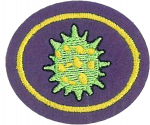Especialidades JA/Virus/Respuestas
| Virus | ||
|---|---|---|
| Asociación General
|
Destreza: 2 Año de introducción: 2012 |
|
Requisitos
|
La especialidad de Virus es un componente de la Maestría Salud y Ciencia. |
1
1a
1b
1c
1d
1e
1f
2
2a
2b
2c
3
3a
3b
3c
3d
3e
3f
3g
3h
With more than one-third of the world’s population living in areas at risk for infection, dengue virus is a leading cause of illness and death in the tropics and subtropics. As many as 400 million people are infected yearly. Dengue is caused by any one of four related viruses transmitted by mosquitoes. There are not yet any vaccines to prevent infection with dengue virus and the most effective protective measures are those that avoid mosquito bites. When infected, early recognition and prompt supportive treatment can substantially lower the risk of medical complications and death. http://www.cdc.gov/dengue/
4
The flu and the common cold are both respiratory illnesses but they are caused by different viruses. Because these two types of illnesses have similar flu-like symptoms, it can be difficult to tell the difference between them based on symptoms alone. Special tests that usually must be done within the first few days of illness can be carried out, when needed to tell if a person has the flu.
In general, the flu is worse than the common cold, and symptoms such as fever, body aches, extreme tiredness, and dry cough are more common and intense. Colds are usually milder than the flu. People with colds are more likely to have a runny or stuffy nose. Colds generally do not result in serious health problems, such as pneumonia, bacterial infections, or hospitalizations.
[Source CDC http://www.cdc.gov/flu/about/qa/coldflu.htm]
The flu continues to mutate, creating hundreds of strains a year. Therefore vaccines need to be developed with educated guesses as to which will be strain that spreads most. Sometimes the guess is wrong, or a new dangerous strain gets out of control.
5
The word prion, named in 1982 by Stanley B. Prusiner, is short for “proteinaceous infectious particle” and the word is derived from the words protein and infection. While viruses (and all other known infectious agents, including bacteria, fungi, and parasites) universally contain DNA or RNA, prions contain neither. Instead they are a protein that can fold in multiple, structurally distinct ways, at least one of which is self-propagating and transmissible to other prion proteins. This form of replication leads to disease that is similar to viral infection.
The first prion protein discovered in mammals is the major prion protein (PrP). This infectious agent causes mammalian transmissible spongiform encephalopathies, including bovine spongiform encephalopathy (BSE, also known as "mad cow disease") and scrapie in sheep. In humans, PrP causes Creutzfeldt-Jakob Disease (CJD), variant Creutzfeldt-Jakob Disease (vCJD), Gerstmann–Sträussler–Scheinker syndrome, Fatal Familial Insomnia and kuru.
All known prion diseases in mammals affect the structure of the brain or other neural tissue and all are currently untreatable and universally fatal.
6
6a
A pandemic (from Greek πᾶν pan "all" and δῆμος demos "people") is an epidemic of infectious disease that has spread through human populations across a large region; for instance multiple continents, or even worldwide. A widespread endemic disease that is stable in terms of how many people are getting sick from it is not a pandemic. Further, flu pandemics generally exclude recurrences of seasonal flu. More recent pandemics include the HIV pandemic as well as the 1918 and 2009 H1N1 pandemics. The Black Death was a devastating pandemic, killing over 75 million people.
Be sure the pandemic you cover is caused by a virus, since many pandemics are bacterial. Historic or current viral pandemics include:
- Yellow fever In 1927 yellow fever virus became the first human virus to be isolated. Yellow fever has been a source of several devastating epidemics.Cities as far north as New York, Philadelphia, and Boston were hit with epidemics. In 1793, one of the largest yellow fever epidemics in U.S. history killed as many as 5,000 people in Philadelphia—roughly 10% of the population. About half of the residents had fled the city, including President George Washington. In colonial times, West Africa became known as "the white man's grave" because of malaria and yellow fever. Yellow fever remains a serious problem in Africa.
- Measles is an endemic disease, meaning that it has been continually present in a community, and many people develop resistance. In populations that have not been exposed to measles, exposure to a new disease can be devastating. In 1529, a measles outbreak in Cuba killed two-thirds of the natives who had previously survived smallpox. The disease had ravaged Mexico, Central America, and the Inca civilization. Before the vaccine was introduced in 1963, there were an estimated 3–4 million cases in the U.S. each year. Measles killed around 200 million people worldwide over the last 150 years. In 2000 alone, measles killed some 777,000 worldwide out of 40 million cases globally.
- Influenza pandemic
- Ebola
- HIV/AIDS considered the main viral long term pandemic
- COVID-19 Also known as COVID-19.
6b
6c
Referencias
- Categoría: Tiene imagen de insignia
- Categoría:Libro de Respuestas de Especialidades JA/Especialidades
- Categoría:Libro de Respuestas de Especialidades JA
- Categoría:Libro de Respuestas de Especialidades JA/Nivel de Destreza 2
- Categoría: Libro de respuestas de especialidades JA/Especialidades introducidas en 2012
- Categoría:Libro de Respuestas de Especialidades JA/Asociación General
- Adventist Youth Honors Answer Book/Health and Science/es
- Adventist Youth Honors Answer Book/Health and Science/Primary/es
- Categoría:Libro de Respuestas de Especialidades JA/Etapa 0
- Categoría:Libro de Respuestas de Especialidades JA/Maestría Salud y Ciencia/C

